The emerging plays in infrastructure
In parts of the world where COVID-19 is more under control, activity is returning to normal,
particularly in toll roads and freight rail. Work-from-home is happening but with limited impact
on road traffic. Airport passenger numbers are climbing especially as vaccines are delivered.
With COVID-19 vaccine rollouts under way in many countries (Figure 1), financial markets are looking toward the next stage of a post-vaccine world. With the huge disruption COVID-19 has caused our daily lives, as infrastructure investors, our (virtual) water cooler discussions invariably centre on the work and movement patterns that may prevail in the future.
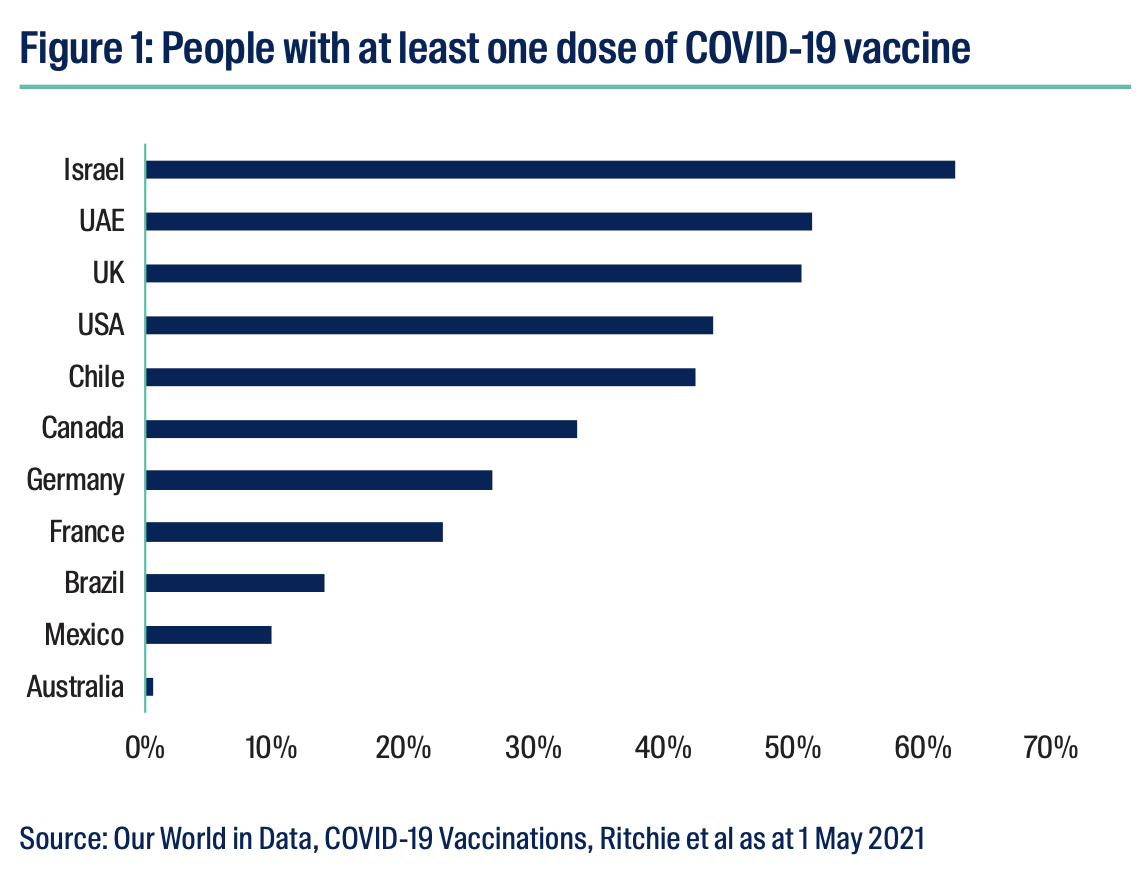
This note analyses a range of tangible evidence across various geographies where COVID-19 is largely under control, to consider what the new-normal might look like for various infrastructure sectors.
Infrastructure assets associated with the movement of freight have seen the least disruption, perhaps unsurprising given the mobility restrictions are on people, not goods. Toll road traffic has quickly rebounded to pre-pandemic levels with the work-from-home (WFH) effect being even less impactful than our already optimistic views. Airport volumes, particularly domestic passengers, have climbed where COVID-19 is well controlled and are strengthening as vaccination coverage rolls out.
Freight leading the way out
Infrastructure assets bring people together but one of the ways to combat COVID-19 is to stay apart. Whilst this has caused a significant impact on infrastructure associated with moving people, those assets focused on moving freight have been more immune.
The world’s initial reaction to the spread of COVID-19 in early 2020
caused severe disruption. However, once society found a middle
ground to keep the industrial economy running, volumes
normalised rather quickly. US freight rail volumes have been
notably resilient. With government stimulus working its way
through the American economy it is expected that volumes will
continue to pick up.
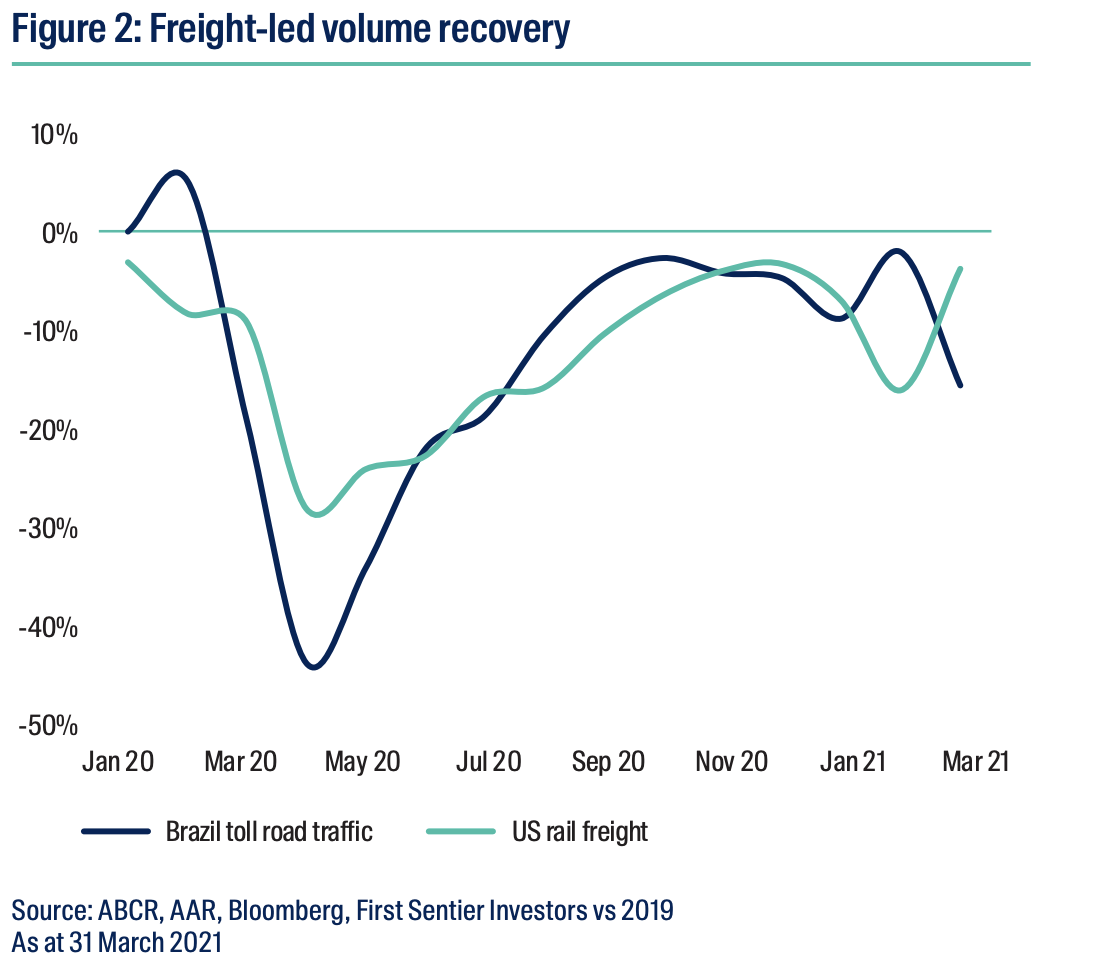
Brazilian toll road volumes also quickly returned to 2019 levels, led by heavy vehicle volumes. Given COVID-19 remains less under control there, it is perhaps surprising that road volumes have been so resilient. However, heavy vehicles represent almost 50% of Brazilian traffic. This is well above other toll roads around the world where trucks typically represent one-tenth to one-quarter of volumes.
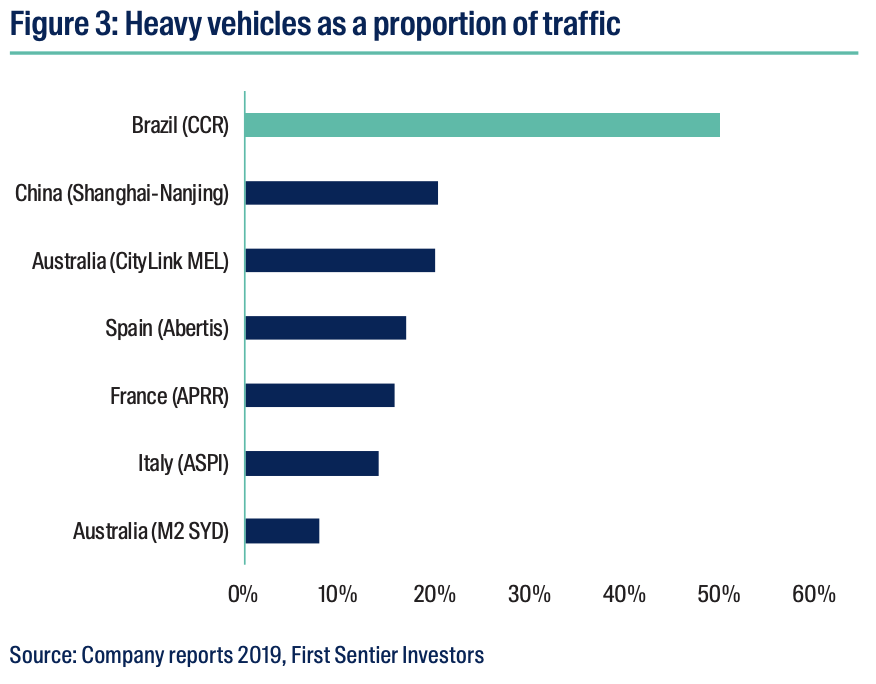
Toll roads less impacted by work-from-home
Many millions of words have been written exploring the future of the office, travel and work; and on predictions of future human behaviour. The subject of WFH has drawn a full spectrum of views, from some corporates claiming it is “an aberration”1 to others who are providing staff with opportunities to work from anywhere with an open-ended timeframe. This has raised fears of a structural decline in toll road traffic once we get COVID-19 under control.
At the risk of being accused of home market bias, we have
considered Sydney toll road traffic as an example of how WFH
may affect toll road volumes. Sydney is one of the few places in
the world where COVID-19 is more under control. There are
relatively few restrictions on the movement or gathering of people,
enabling it to serve as a leading indicator of how hybrid working
environments could impact people flows.
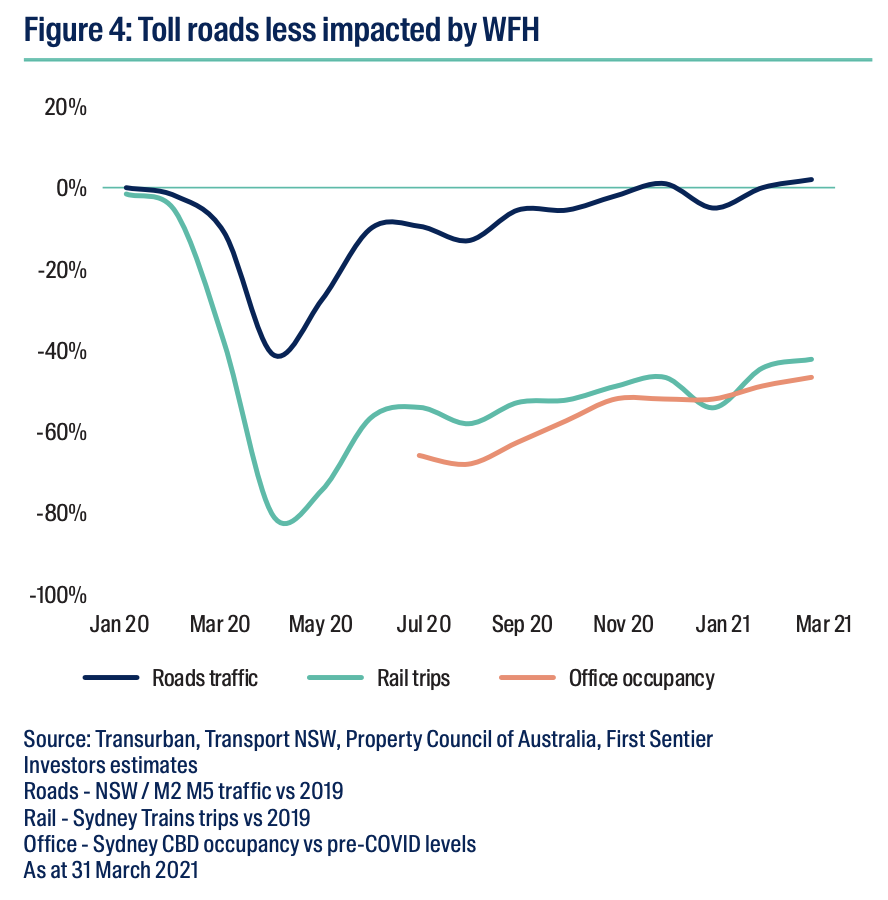
As per Figure 4, the data over 2020 and early 2021 has shown that whilst WFH has clearly impacted CBD office occupancy (consistent with anecdotal evidence of 2-3 days in the office and surveys of a desire to spend some time working from home), the impact on toll road traffic is much less pronounced. In fact, on certain roads, traffic is back to pre-pandemic levels.
We believe there are a number of reasons behind the resilience in toll road traffic:
- Not all road traffic is office commuter traffic and not all occupations are able to work from home. Medical, services, construction, manufacturing, education are examples of some industries where it is more challenging to work virtually.
- Modal shift from public transport / trains to private vehicles as drivers are better equipped to practise social distancing. Figure 4 shows the decline in passenger rail was greater than roads and the recovery is slower to materialise.
- Induced demand effect on toll roads
- Positive effect of more truck trips from e-commerce / online shopping.
Induced demand
Induced demand is recognised amongst transport planners and academics as the phenomenon where additional road capacity brings extra demand. For example, Beck and Bliemer found evidence of a 38% increase in Sydney Harbour crossings three years after a new tunnel was opened to supplement the existing bridge.
Whilst there are public health interdependences at play during this
pandemic, it is not unreasonable to expect that if road congestion
was lower (in effect freeing up capacity) it encourages commuters
to switch from one mode of transport (public / rail) to another
(private vehicles).
Looking further afield, Israel has been an early mover in vaccine
coverage (see Figure 1). As daily case counts have decreased and
restrictions lifted, traffic congestion in Tel Aviv has trended back
towards 2019 levels as per data from TomTom, a navigation firm.
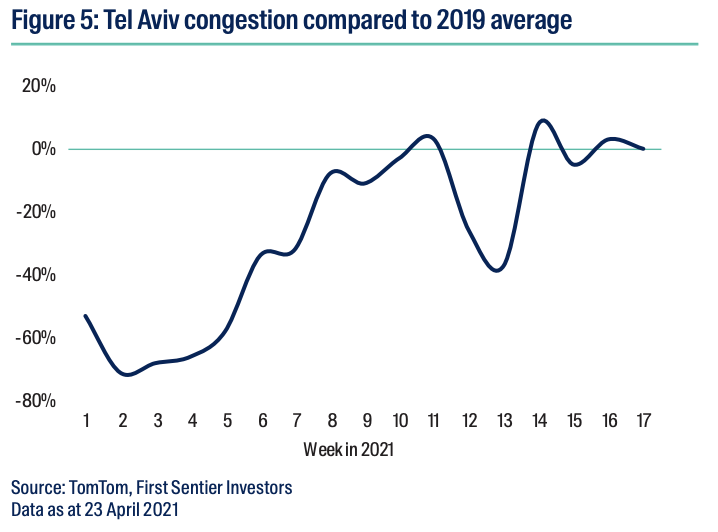
In France, which has navigated through various lockdowns, traffic
volumes on long distance inter-city road networks quickly reverted
to the prior year’s levels once lockdowns were lifted, briefly, in
mid-2020. Hopefully as vaccine coverage increases, the need for
severe lockdowns will decrease.
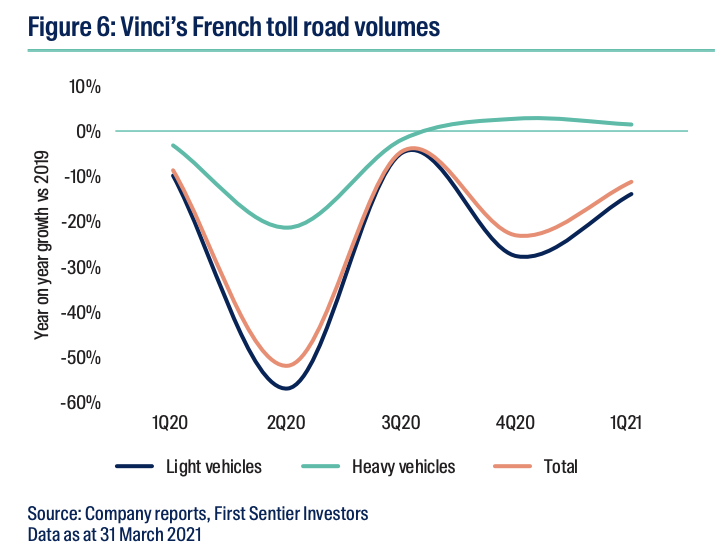
We appreciate these are selected examples and hope to expand
our analysis further as more regions ease out of lockdowns.
Further, we understand each city has varying choices between
road and rail. However these examples further support our
investment thesis that in a COVID-19 controlled environment
(perhaps aided by effective vaccines), toll road volumes have a
good chance of rapidly recovering to pre-pandemic levels.
Glimmers of hope for air travel
No part of the infrastructure universe has borne the brunt of COVID-19 more heavily than airports. As eager travellers wait for borders to open up, how do we gain confidence that demand for air travel will actually return?
The aviation industry has a long history of rebounding from unpredictable shocks such as terrorism and epidemics. It has previously taken anywhere from a few months to a few years to recover from prior events. Provided vaccine efficacy and take-up remains high for COVID-19, our expectation is that air travel volumes will recover again, just as they have in the past. We believe humans are curious and in the long-term will venture out again. In the near term, we can look at some large air travel markets to provide assurance that there is a path to recovery once restrictions are eased.
China was one of the first countries to emerge from lockdowns, and in the second half of 2020 saw domestic travel rapidly trend towards 2019 levels despite the absence of vaccines at the time. The United States dealt with a number of waves of coronavirus in 2020 but as vaccines have been progressively rolled out, the demand for air travel, as measured by the number of airport security checks, has accelerated as well.
Figure 7 gives us cause to be optimistic, as it demonstrates a
strong underlying desire to travel despite limited vaccine
availability at the time. This bodes well for demand in the future
when more vaccines are available. These trends are consistent
with our expectations that an air travel recovery will be led by
domestic travel, followed by leisure/visiting friends and relatives
(VFR) passengers - with business travel the most debatable
category.
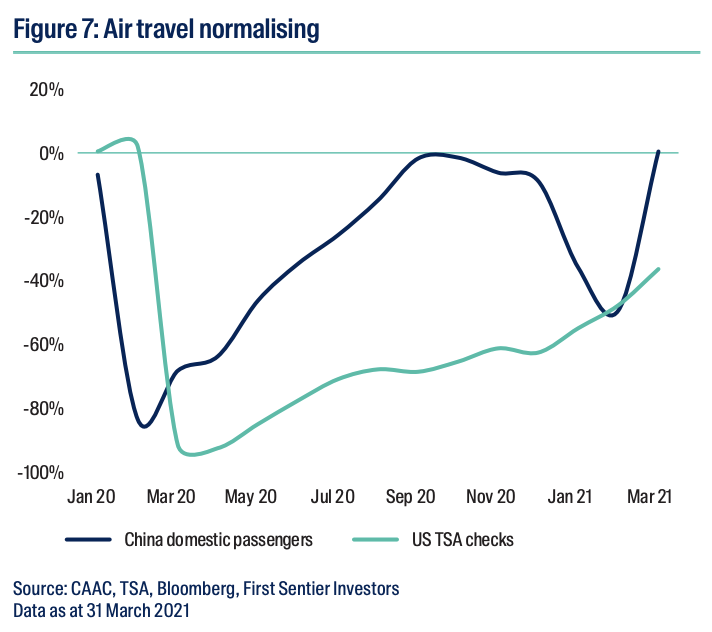
Some bold claims have been made about the demise of business travel with some business leaders calling for more than 50% to disappear. Conversely, an executive from a large European infrastructure company recently observed that air travel has grown over many years, despite the availability of modern communications. This points to a fundamental appetite to travel.
Whilst a great deal can be accomplished by video meetings, we look forward to travelling again to conduct investment due diligence, meet investors and inspect assets in our role as bottom-up fundamental infrastructure investors. Anecdotally, we are being offered in-person meetings in the US again. Our favourite annual US communications infrastructure industry conference is three months later than usual, but is planned to be in-person.
It is easy to imagine a scenario faced by corporates when
vaccination rates are high and their suppliers, customers or
competitors are attending an in-person event. In that situation the
decision of whether or not to travel may be less clear cut.
Conclusion
2020 was a year like no other for Global Listed Infrastructure, with
significant disruptions to road, rail and airport volumes. As some
parts of the world are managing to get COVID-19 under control or
are becoming highly vaccinated, they are re-opening their
economies. Our analysis shows clear evidence that transport
infrastructure activity, by and large, then rapidly returns to
pre-pandemic levels.
Learn more
We invest in shares of infrastructure companies around the world, including operating assets from the transport, utilities, energy and communications sectors. The assets held by these companies typically offer high barriers to entry, pricing power, and structural growth. For further information, please visit our website.
5 topics

